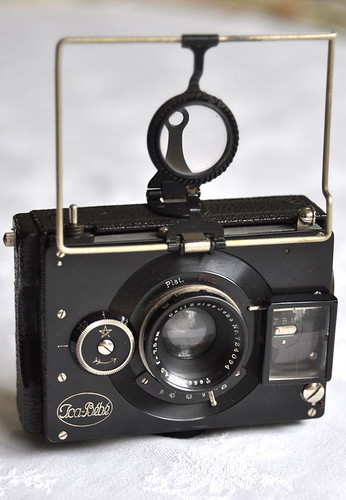Difference between revisions of "Ica Bébé"
(+ note on accents in the name; they appear only on the camera itself, not in the catalogues.) |
m (→Second model, about 1925: deleted extra semicolon) |
||
| Line 14: | Line 14: | ||
==Second model, about 1925== | ==Second model, about 1925== | ||
ICA catalogues of about 1925 show another model of the camera, and describe it as new.<ref name=ECat/><ref name=GCat/> It is a strut-folding camera, now made in two sizes. Each has a dial-set [[Compur]] shutter with speeds from 1s to 1/250 second. | ICA catalogues of about 1925 show another model of the camera, and describe it as new.<ref name=ECat/><ref name=GCat/> It is a strut-folding camera, now made in two sizes. Each has a dial-set [[Compur]] shutter with speeds from 1s to 1/250 second. | ||
| − | * Model A (listed as model 40/2 in the German catalogue) is for 4.5x6cm (1¾ x 2<sup>3</sup>/<sub>8</sub> | + | * Model A (listed as model 40/2 in the German catalogue) is for 4.5x6cm (1¾ x 2<sup>3</sup>/<sub>8</sub> inch) plates, or film-packs. with Tessar 3-inch f4.5 lens |
* Model B (listed as model 41/2 in the German catalogue) is for 6.5x9cm (2½ x 3½ inch) plates. | * Model B (listed as model 41/2 in the German catalogue) is for 6.5x9cm (2½ x 3½ inch) plates. | ||
The US catalogue lists the cameras only with f/4.5 Tessar lenses, 3- and 4-inch respectively; the German one lists the smaller camera with a choice of f/4.5 Tessar or f/3.5 Triotar. Both catalogues make a point of stating that focusing is not by a helical mount but by rotating the front element: as the picture here shows, this required two different focus markers, because of the different planes of focus for plate-holders and the film-pack adapter. | The US catalogue lists the cameras only with f/4.5 Tessar lenses, 3- and 4-inch respectively; the German one lists the smaller camera with a choice of f/4.5 Tessar or f/3.5 Triotar. Both catalogues make a point of stating that focusing is not by a helical mount but by rotating the front element: as the picture here shows, this required two different focus markers, because of the different planes of focus for plate-holders and the film-pack adapter. | ||
The German catalogue states that the larger camera has front rise. The cameras have both an 'Ikonometer' folding frame-finder, incorporating a close-up lens, and a smaller [[Viewfinder#Newton_finder|Newton finder]]. | The German catalogue states that the larger camera has front rise. The cameras have both an 'Ikonometer' folding frame-finder, incorporating a close-up lens, and a smaller [[Viewfinder#Newton_finder|Newton finder]]. | ||
| − | |||
==Links== | ==Links== | ||
Revision as of 14:21, 2 December 2013

|
| image by Jacques Lepine (Image rights) |
First model, 1906
The Bebe (or Bébé; the name appears accented on the camera itself, as pictured here, but is written without the accents in both the English and German catalogues[1][2]) is a small plate camera made by ICA. The first model was made in 1906, and takes 4,5 x 6cm glass plates. The lens is a Zeiss Triotar 7.5 cm f/3.5, and the camera allows some lens board movements.
Second model, about 1925
ICA catalogues of about 1925 show another model of the camera, and describe it as new.[1][2] It is a strut-folding camera, now made in two sizes. Each has a dial-set Compur shutter with speeds from 1s to 1/250 second.
- Model A (listed as model 40/2 in the German catalogue) is for 4.5x6cm (1¾ x 23/8 inch) plates, or film-packs. with Tessar 3-inch f4.5 lens
- Model B (listed as model 41/2 in the German catalogue) is for 6.5x9cm (2½ x 3½ inch) plates.
The US catalogue lists the cameras only with f/4.5 Tessar lenses, 3- and 4-inch respectively; the German one lists the smaller camera with a choice of f/4.5 Tessar or f/3.5 Triotar. Both catalogues make a point of stating that focusing is not by a helical mount but by rotating the front element: as the picture here shows, this required two different focus markers, because of the different planes of focus for plate-holders and the film-pack adapter. The German catalogue states that the larger camera has front rise. The cameras have both an 'Ikonometer' folding frame-finder, incorporating a close-up lens, and a smaller Newton finder.
Links
- Ica cameras 1900-1910 at www.kameramuseum.ch [1]
- Strut-folding Bebe (not clear which size; the camera is missing its Ikonometer finder) in Theo Ochsenbein's Flickr account
Notes
- ↑ 1.0 1.1 ICA Cameras English-language catalogue, 1925 (the upper link), page 39, at Mike Butkus' Orphan Cameras.
- ↑ 2.0 2.1 ICA Cameras German-language catalogue, 1925, page 3, at Camera Eccentric.